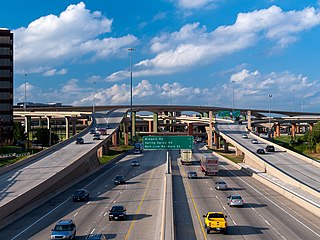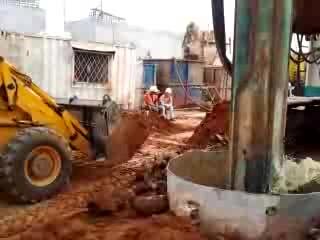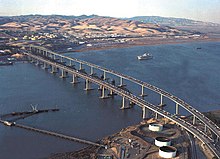
The Apollo command and service module (CSM) was one of two principal components of the United States Apollo spacecraft, used for the Apollo program, which landed astronauts on the Moon between 1969 and 1972. The CSM functioned as a mother ship, which carried a crew of three astronauts and the second Apollo spacecraft, the Apollo Lunar Module, to lunar orbit, and brought the astronauts back to Earth. It consisted of two parts: the conical command module, a cabin that housed the crew and carried equipment needed for atmospheric reentry and splashdown; and the cylindrical service module which provided propulsion, electrical power and storage for various consumables required during a mission. An umbilical connection transferred power and consumables between the two modules. Just before reentry of the command module on the return home, the umbilical connection was severed and the service module was cast off and allowed to burn up in the atmosphere.

The Chesapeake Bay Bridge–Tunnel is a 17.6-mile (28.3 km) bridge–tunnel that crosses the mouth of the Chesapeake Bay between Delmarva and Hampton Roads in the U.S. state of Virginia. It opened in 1964, replacing ferries that had operated since the 1930s. A major project to dualize its bridges was completed in 1999, and in 2017 a similar project was started to dualize one of its tunnels.

Directional drilling is the practice of drilling non-vertical bores. It can be broken down into four main groups: oilfield directional drilling, utility installation directional drilling, directional boring, and surface in seam (SIS), which horizontally intersects a vertical bore target to extract coal bed methane.

A drilling rig is an integrated system that drills wells, such as oil or water wells, or holes for piling and other construction purposes, into the earth's subsurface. Drilling rigs can be massive structures housing equipment used to drill water wells, oil wells, or natural gas extraction wells, or they can be small enough to be moved manually by one person and such are called augers. Drilling rigs can sample subsurface mineral deposits, test rock, soil and groundwater physical properties, and also can be used to install sub-surface fabrications, such as underground utilities, instrumentation, tunnels or wells. Drilling rigs can be mobile equipment mounted on trucks, tracks or trailers, or more permanent land or marine-based structures. The term "rig" therefore generally refers to the complex equipment that is used to penetrate the surface of the Earth's crust.

The High Five Interchange is one of the first five-level stack interchanges built in Dallas, Texas. Located at the junction of the Lyndon B. Johnson Freeway and the Central Expressway, it replaces an antiquated combination interchange constructed in the 1960s.

Dworshak Dam is a concrete gravity dam in the western United States, on the North Fork of the Clearwater River in north central Idaho. In Clearwater County, the dam is located approximately four miles (6 km) northwest of Orofino and impounds the Dworshak Reservoir for flood control and hydroelectricity generation. By capacity, the reservoir is the largest in Idaho and fourth-largest in the Pacific Northwest.

Mars is a permanent offshore drilling and production tension-leg oil platform (TLP) operating in Mississippi Canyon blocks 762, 763, 806, 807, 850 and 851 in the Gulf of Mexico and was approved by the MMS in December 1992 with production beginning on July 8, 1996. The leases were acquired by Shell in 1985 and 1988. The platform is a joint venture between Shell Oil Company and BP, with Shell owning the majority share and operating the facility.

A modern core drill is a drill specifically designed to remove a cylinder of material, much like a hole saw. The material left inside the drill bit is referred to as the core.

Pineview Dam is located in Ogden Canyon, 7 miles (11 km) east of Ogden, Utah, United States.

Lake Perris is an artificial lake completed in 1973. It is the southern terminus of the California State Water Project, situated in a mountain-rimmed valley between Moreno Valley and Perris, in what is now the Lake Perris State Recreation Area. The park offers a variety of recreational activities. Because of this and the lake's proximity to major population centers, it is very crowded during the summer months.
Directional boring, also referred to as horizontal directional drilling (HDD), is a minimal impact trenchless method of installing underground utilities such as pipe, conduit, or cables in a relatively shallow arc or radius along a prescribed underground path using a surface-launched drilling rig. Directional boring offers significant environmental advantages over traditional cut and cover pipeline/utility installations. The technique is routinely used when conventional trenching or excavating is not practical or when minimal surface disturbance is required.

A deep foundation is a type of foundation that transfers building loads to the earth farther down from the surface than a shallow foundation does to a subsurface layer or a range of depths. A pile or piling is a vertical structural element of a deep foundation, driven or drilled deep into the ground at the building site.

The First National Bank Tower is a 45-story office skyscraper located at 1601 Dodge Street in downtown Omaha, Nebraska, United States, and the official headquarters of First National Bank of Omaha. At 634 ft (193 m) it is the tallest building in Omaha and the state. It has been since its completion, overtaking the 30-story Woodmen Tower located nearby. Construction began in April 1999 and lasted until 2002, with the building's completion being the subject of ACEC and Emporis awards.

The Bouri Offshore Field is part of Block NC-41, which is located 120 kilometers (75 mi) north of the Libyan coast in the Mediterranean Sea. It was first discovered in 1976 at a depth of 8,700 feet (2,700 m) and is estimated to contain 4.5 billion barrels (720,000,000 m3) in proven recoverable crude oil reserves and 3.5 trillion cubic feet (99 km3) of associated natural gas with an annual production potential of 6 billion m³. Bouri is considered the largest producing oilfield in the Mediterranean.

Krishna Godavari Basin is a peri-cratonic passive margin basin in India. It is spread across more than 50,000 square kilometres in the Krishna River and Godavari River basins in Andhra Pradesh. The site is known for the D-6 block where Reliance Industries discovered the biggest natural gas reserves in India in 2003.

The Alva B. Adams Tunnel is the principal component of the largest transmountain water project in Colorado, the Colorado-Big Thompson Project (C-BT). The tunnel transfers water from the western slope of the Colorado River drainage to the eastern Front Range of Colorado. It is 13.1 miles (21.1 km) long, with a concrete lined diameter of 9.75 feet (2.97 m). The tunnel drops 109 feet (33 m) in elevation along its length and runs in a straight line under the Continental Divide from west to east, passing under Otis Peak in Rocky Mountain National Park. At its deepest point, the tunnel is about 3,800 feet (1,200 m) below the surface of the mountain peaks. Construction began on 15 June 1940, but was suspended as a result of World War II priorities, from the end of 1942 to August 1943. The tunnel was holed through on 31 March 1944, an event that was broadcast throughout the United States by NBC Radio. The tunnel was posthumously named for its chief advocate, US Senator Alva B. Adams.

The Devil's Cigarette Lighter was a natural gas well fire at Gassi Touil in the Sahara Desert of Algeria. The fire was ignited on November 6, 1961, and burned until being extinguished by Red Adair and his colleagues, who used explosives to deprive the flame of oxygen, on April 28, 1962.
The Marble Canyon Dam, also known as the Redwall Dam, was a proposed dam on the Colorado River in Arizona, United States. The dam was intended to impound a relatively small reservoir in the central portion of Marble Canyon to develop hydroelectric power. Plans centered on two sites between miles 30 and 40 in the canyon. At one point a 38-mile (61 km) tunnel was proposed to a site just outside Grand Canyon National Park to develop the site's full power generation potential, reducing the Colorado River to a trickle through the park.

Abrahams Creek is a tributary of the Susquehanna River in Luzerne County, Pennsylvania, in the United States. It is approximately 10.7 miles (17.2 km) long and flows through Franklin Township, Dallas Township, Kingston Township, West Wyoming, Wyoming, and Forty Fort. The watershed of the creek has an area of 17.4 square miles (45 km2) and occupies portions of nine municipalities in northeastern Luzerne County. The watershed is divided into the upper Abraham Creek watershed and the lower Abraham Creek watershed, which are joined by a canyon known as The Hollow. The upper part of the watershed is mostly rural, but the lower part is heavily urbanized. The creek's channel has been heavily modified in many places. Its drainage basin is designated as a Coldwater Fishery and a Migratory Fishery.
Turkey Creek is a stream spanning Johnson and Wyandotte counties in Kansas, within the Kansas City metropolitan area of the United States. It is a tributary of the Kansas River, with its mouth near downtown Kansas City, Kansas. It is not the Turkey Creek in Dickinson County, Kansas.

















